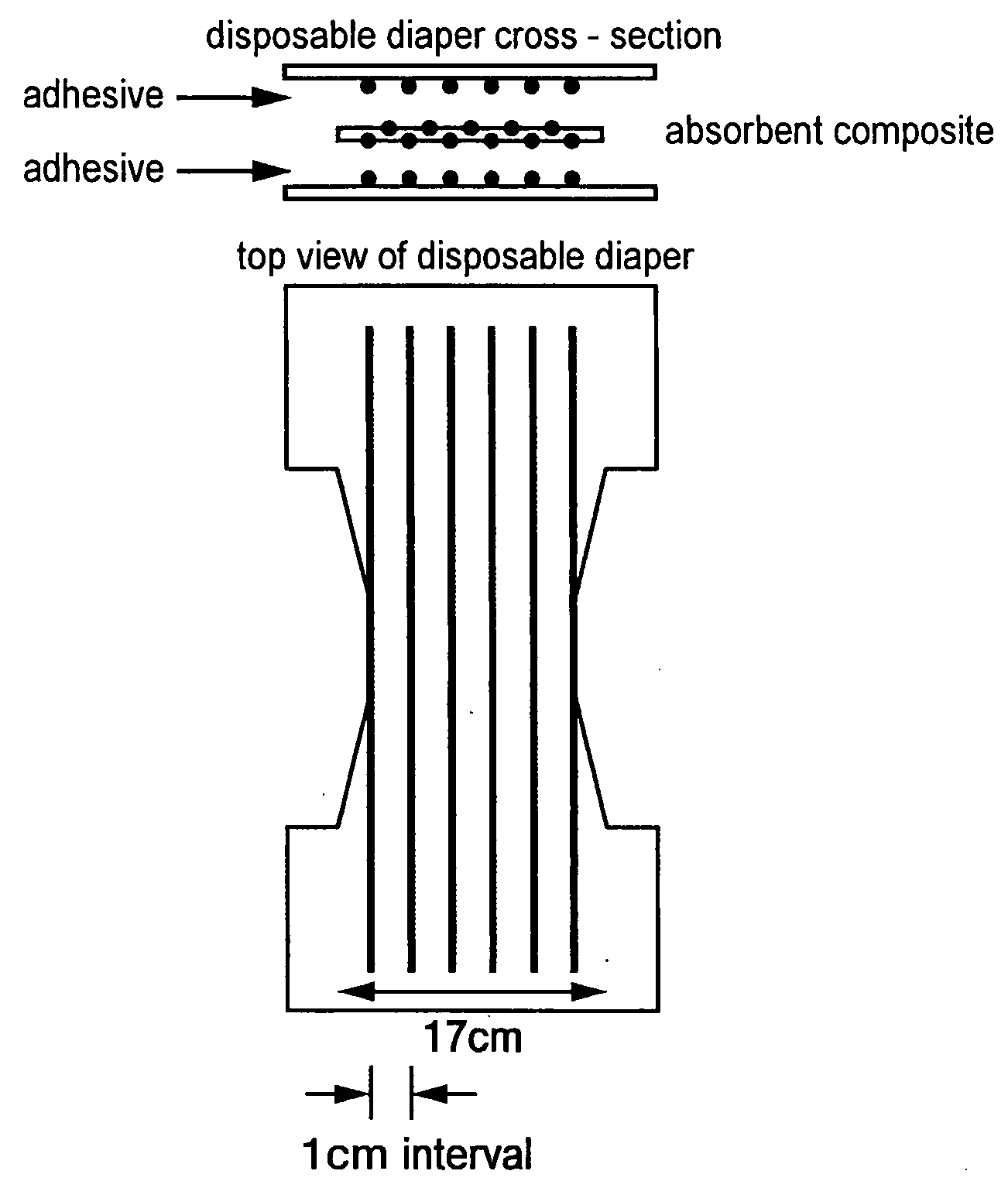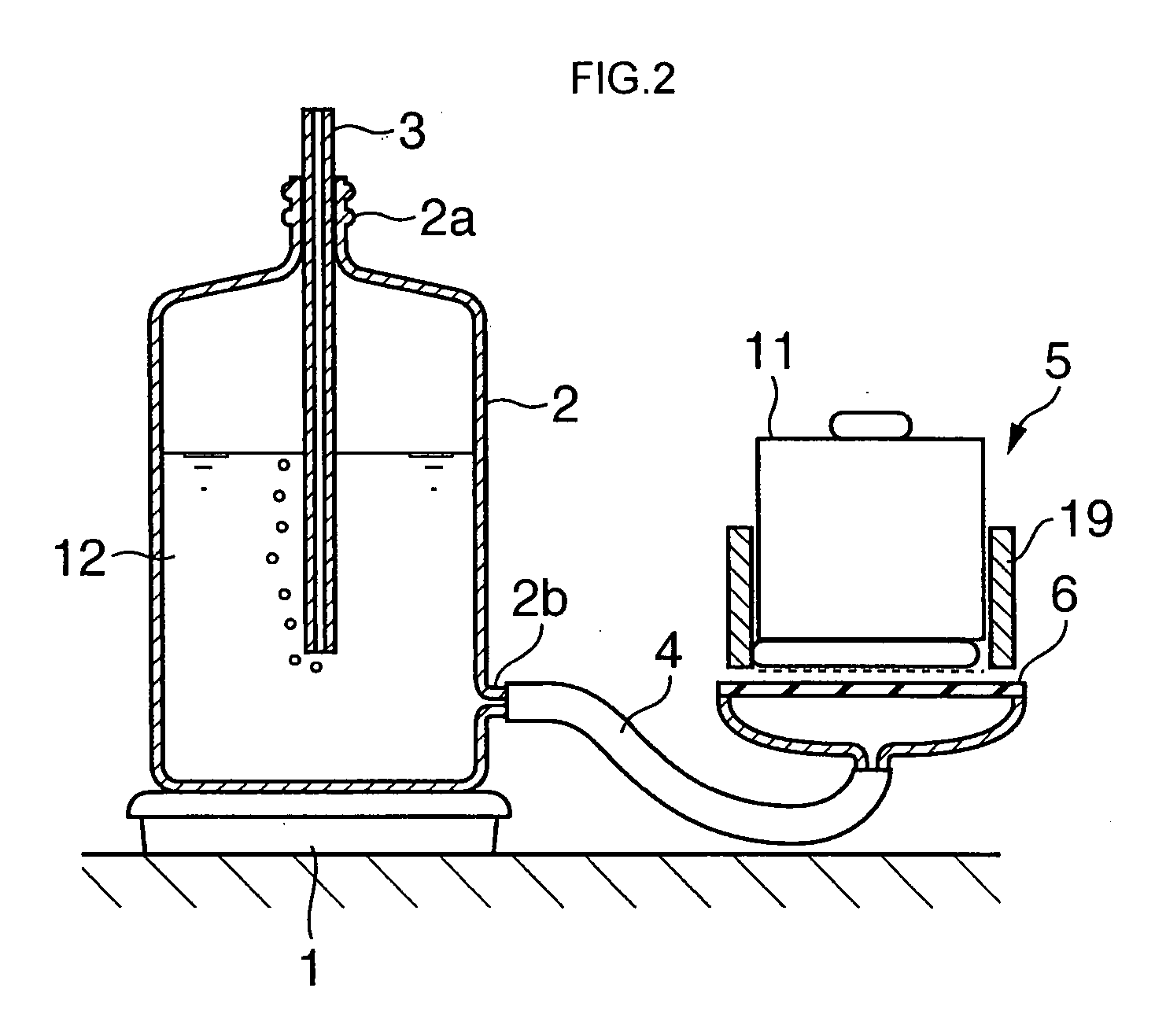Absorbent composite material and method for manufacturing the same
a composite material and absorber technology, applied in the direction of bandages, transportation and packaging, other chemical processes, etc., can solve the problems of inability to properly disperse liquid, inability to properly distribute and disperse liquid when diapers are actually used, and inability to inhibit liquid dispersal, etc., to achieve the effect of high liquid dispersibility and liquid holding capacity, simplified process of manufacturing sanitary materials, and reduced use of fabric and other materials
- Summary
- Abstract
- Description
- Claims
- Application Information
AI Technical Summary
Benefits of technology
Problems solved by technology
Method used
Image
Examples
examples
[0246]Specific examples of the present invention are given below together with comparative examples, and the present invention is not limited to these examples.
Manufacturing 1
[0247]Acrylic acid of special grade reagent from Wako Pure Chemical was purified by distillation and used. 100 g of this acrylic acid was dissolved in 91.02 g of water. This aqueous solution was cooled in an ice bath and maintained at a liquid temperature of 30° C. or less, and 117.94 g of 25 wt % aqueous ammonia solution were gradually added to the solution with stirring to give a 40 wt % ammonium acrylate aqueous solution (neutralization rate 100%).
[0248]90 g of this 40 wt % ammonium acrylate aqueous solution and 0.0187 g of N,N′-methylenebisacrylamide were added to a 300 ml separable flask. The flask was immersed in a water bath so as to maintain a liquid temperature of 30° C. The water bath was deoxygenated by bubbling with nitrogen gas to substitute the reaction system with nitrogen. 0.43 g of 42 wt % aque...
manufacturing example 3
[0250]81.73 g of acrylic acid of special grade reagent from Wako Pure Chemical, 185.71 g of water and 31.78 g of sodium hydroxide were slowly added to a 300 ml flask while the flask was being cooled so that the liquid temperature did not exceed 30° C. (salt concentration 70%). 90 g of this monomer solution and 0.0561 g of N,N′-methylenebisacrylamide were added to a 300 ml separable flask. The flask was immersed in a water bath so as to maintain a liquid temperature at 30° C. The water bath was deoxygenated by bubbling with nitrogen gas to substitute the reaction system with nitrogen. 0.0826 g of 30 wt % of and 0.0518 g of Rongalite, each dissolved in 1 g of water, were added to initiate polymerization. After 10 minutes, the internal temperature had risen to 70° C. from the initial temperature of 30° C. 5 minutes after the internal temperature has reached to the maximum temperature, the solution was heated for 3 hours in a water bath so as to maintain an internal temperature at 75° C...
example 1
[0273]A portion of a circle with a diameter of 59.5 mm was cut out from Bemliese® from Asahi Kasei Fibers Corp. (material properties shown in Table 2), and the weight of the portion was 0.0796 g. Bemliese® is a nonwoven fabric made from 100% cellulose continuous-filament. Because it is a cellulose nonwoven fabric, it has excellent absorption properties. Because it is made from the continuous filaments, it is sufficiently strong when containing water and has excellent liquid dispersibility.
[0274]Of the water-absorbent resin particles 1 synthesized in Manufacturing 1, 0.164 g of particles with a particle size of 850 to 1200 μm were arranged on Teflon sheet with a diameter of 59.5 mm so that the particles were not closely packed. This was called Teflon (1). Another Teflon sheet was prepared in the same way and called Teflon (2). The Bemliese® was placed on Teflon (1), and sprayed with 3 ml of water with an atomizer. Teflon (1) was placed upside-down on Teflon (2) with the Bemliese® sid...
PUM
| Property | Measurement | Unit |
|---|---|---|
| particle size | aaaaa | aaaaa |
| contact angle | aaaaa | aaaaa |
| temperature | aaaaa | aaaaa |
Abstract
Description
Claims
Application Information
 Login to View More
Login to View More - R&D
- Intellectual Property
- Life Sciences
- Materials
- Tech Scout
- Unparalleled Data Quality
- Higher Quality Content
- 60% Fewer Hallucinations
Browse by: Latest US Patents, China's latest patents, Technical Efficacy Thesaurus, Application Domain, Technology Topic, Popular Technical Reports.
© 2025 PatSnap. All rights reserved.Legal|Privacy policy|Modern Slavery Act Transparency Statement|Sitemap|About US| Contact US: help@patsnap.com



